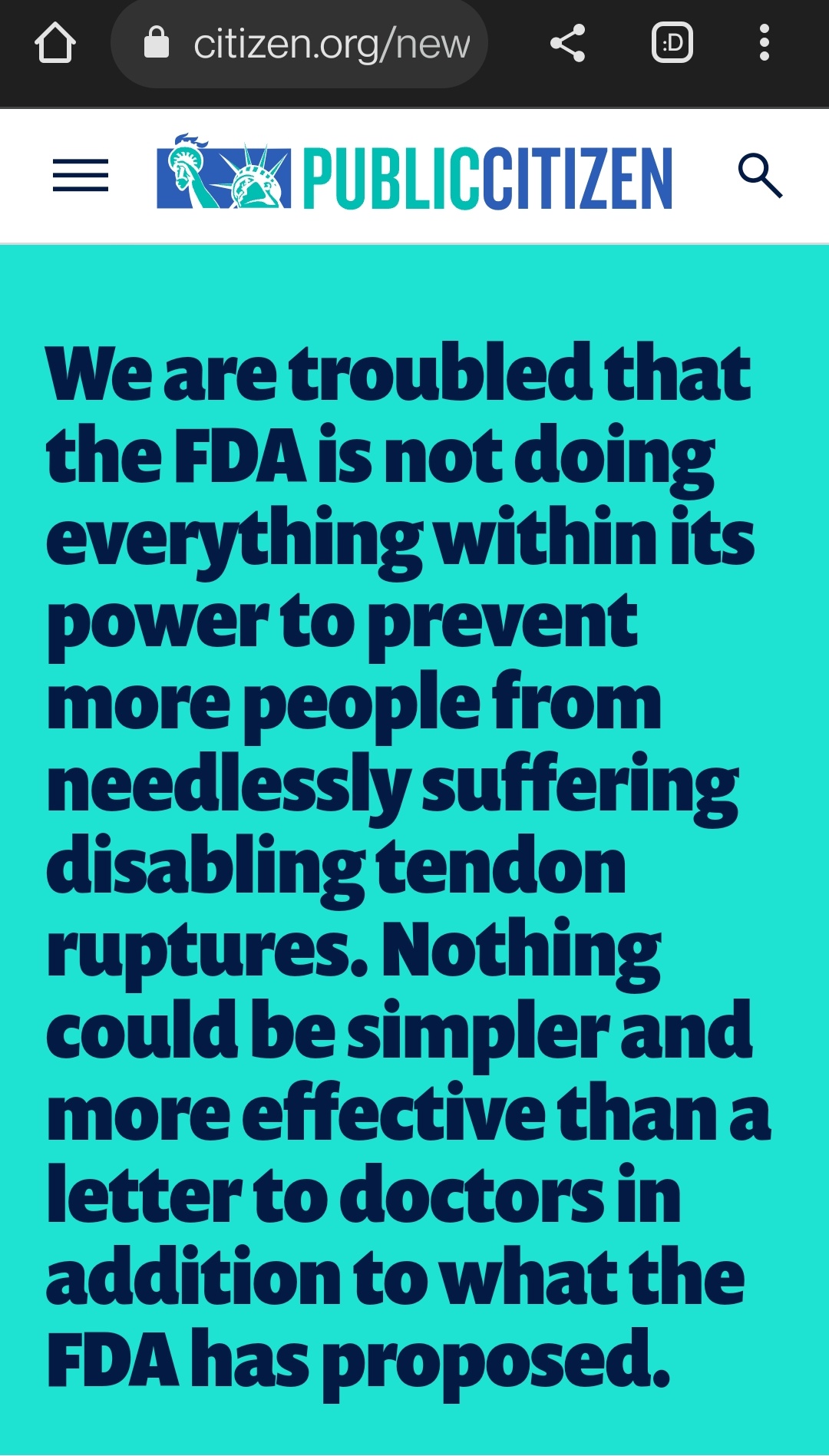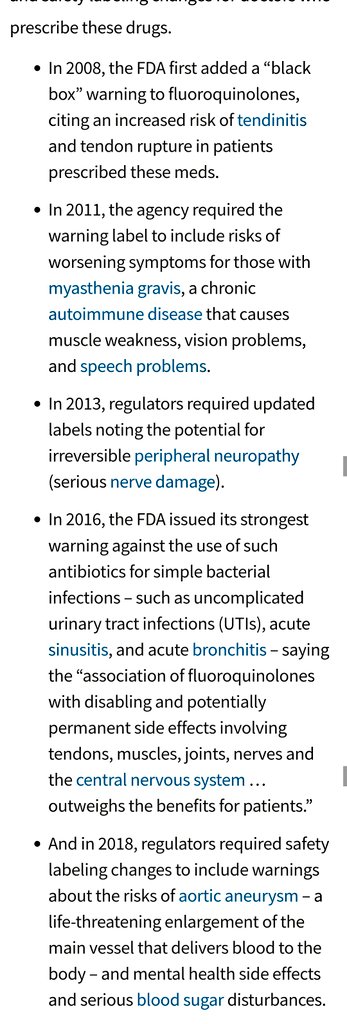Thread
1. Ciprofloxacin, an antibiotic, was approved by the FDA in 1987.
At its peak, ciprofloxacin sales crossed 2 billion euros in 2001.
At one point it was one of the most frequently prescribed antibiotics and it remains a critically important lifesaving antibiotic today.
At its peak, ciprofloxacin sales crossed 2 billion euros in 2001.
At one point it was one of the most frequently prescribed antibiotics and it remains a critically important lifesaving antibiotic today.
2. On October 4, 2001, the CDC reported the first case of anthrax outbreak. At the beginning of the outbreak, ciprofloxacin was the only agent approved by the U.S. Food and Drug Administration for postexposure prophylaxis.
3. What followed was a purchasing frenzy.
Tom Brokaw’s held up a bottle of the drug on camera and closed his NBC Nightly News broadcast with the statement, “In Cipro we trust”. By early November, approximately 32,000 people had initiated prophylaxis with ciprofloxacin.
Tom Brokaw’s held up a bottle of the drug on camera and closed his NBC Nightly News broadcast with the statement, “In Cipro we trust”. By early November, approximately 32,000 people had initiated prophylaxis with ciprofloxacin.
4. This led to people purchasing drugs online from questionable pharmacies and hoarding it, which decreased the overall market supply and led to serious concerns surrounding both its availability and the health impacts of spurious unregulated pharmaceutical drugs.
5. One paper found 59 websites selling ciprofloxacin without a prescription.
Of these 23 were created within 2 weeks of the first media drumming up panic.
Not surprisingly these were the same outlets that decried these unethical business practices.
www.ncbi.nlm.nih.gov/pmc/articles/PMC6700526/
Of these 23 were created within 2 weeks of the first media drumming up panic.
Not surprisingly these were the same outlets that decried these unethical business practices.
www.ncbi.nlm.nih.gov/pmc/articles/PMC6700526/
6. In July 2008, the FDA mandated that all ciprofloxacin products carry a black-box warning indicating an increased risk in adverse events including tendon rupture.
www.ncbi.nlm.nih.gov/pmc/articles/PMC2921747/
www.ncbi.nlm.nih.gov/pmc/articles/PMC2921747/
7. This came about after multiple articles described the phenomenon and a WHO survey in Australia published half a decade earlier showed that tendon disorders associated with ciprofloxacin and other fluoroquinolones were found to be causally associated in 90 percent of cases.
8. The medical literature kept accumulating case reports describing both tendon rupture and and aneurysm formation of blood vessels in multiple different sites, sometimes with catastrophic consequences.
And of course, lawsuits.
There were many lawsuits.
And of course, lawsuits.
There were many lawsuits.
9. On May 12, 2016, the FDA announced it was requiring a stronger "black box" warning advising patients and doctors that these antibiotics may cause potentially permanent damage to muscles, tendons, joints, nerves and the central nervous system. www.drugwatch.com/news/2016/05/16/fda-black-box-warning-for-levaquin-cipro-antibiotic-risk/
10. In 2017, the FDA issued yet another black box warning. This time about increased risk of ruptures or tears in the aorta blood vessel with fluoroquinolones (the parent family of ciprofloxacin) in certain patients.
www.fda.gov/drugs/drug-safety-and-availability/fda-warns-about-increased-risk-ruptures-or-tears-aorta...
www.fda.gov/drugs/drug-safety-and-availability/fda-warns-about-increased-risk-ruptures-or-tears-aorta...
11. Fluoroquinolone makers have faced thousands of lawsuits from patients. J&J alone faced 3,400 lawsuits over Levaquin’s (ciprofloxacins cystro drug) links to tendon problems and settled many of those cases.
www.fiercepharma.com/pharma/fda-amps-up-black-box-warnings-antibiotic-class-includes-j-j-s-levaquin-b...
www.fiercepharma.com/pharma/fda-amps-up-black-box-warnings-antibiotic-class-includes-j-j-s-levaquin-b...
12. The first FDA black box warning came about after years of public advocacy and skepticism on part of the FDA regarding the veracity of those claims.Dr. Sidney Wolfe, director of the Health Research Group at Public Citizen, said:
13. Since the 1980s, more than 60,000 patients have reported hundreds of thousands of serious events linked to fluoroquinolones to the FDA, including 6,575 reports of deaths.
www.webmd.com/drug-medication/news/20220705/doctors-still-overprescribing-fluroquinolones-despite-ris...
www.webmd.com/drug-medication/news/20220705/doctors-still-overprescribing-fluroquinolones-despite-ris...
14. Here's the full history of FDA warnings surrounding the fluoroquinolone family of antibiotics (of which ciprofloxacin is a part of)
15. A JAMA study found aortic aneurysm incidence within 90 days of filling a fluoroquinolone prescription was 20% higher compared to other antibiotics.
The risk of abdominal aneurysms was 31% higher and that of aneurysms in iliac artery 61% higher.
www.cidrap.umn.edu/antimicrobial-stewardship/study-links-fluoroquinolones-higher-risk-aneurysm
The risk of abdominal aneurysms was 31% higher and that of aneurysms in iliac artery 61% higher.
www.cidrap.umn.edu/antimicrobial-stewardship/study-links-fluoroquinolones-higher-risk-aneurysm
16. I could go on. But you get the picture.
Here's the bottom line:
Floroquinolones are great antibiotics and life-saving in the right circumstances.
But they're not for everyone and should be used with extreme caution.
Here's the bottom line:
Floroquinolones are great antibiotics and life-saving in the right circumstances.
But they're not for everyone and should be used with extreme caution.
17. They exemplify the pitfalls and the fallacies of the nonsensical "safe and effective"
Are they safe? Mostly, but not always, and only in the context of a positive benefit risk assessment.
Are they effective, yes. But should be used judiciously and considering alternatives.
Are they safe? Mostly, but not always, and only in the context of a positive benefit risk assessment.
Are they effective, yes. But should be used judiciously and considering alternatives.
18. Ciprofloxacin was approved in 1987.
It took nearly 20 years, 2008 to be precise, for the FDA to start putting warning labels on its use, and not before our media glorified them as a one size fits all panacea for a contagion that never was.
It took nearly 20 years, 2008 to be precise, for the FDA to start putting warning labels on its use, and not before our media glorified them as a one size fits all panacea for a contagion that never was.
19. All the while there were warning signs, publications and patients advocacy groups calling for action while pharmaceutical companies repeated ad nauseam that these instances were rare and any reports of their danger greatly exaggerated.
20. Once the gates to the FDA process were opened, every few years these drugs have had more warnings slapped on them.
Surely nobody believes that these side effects took 20 years to manifest. But the gears of bureaucracy turn agonizingly slow.
Surely nobody believes that these side effects took 20 years to manifest. But the gears of bureaucracy turn agonizingly slow.
21. The medical establishment and community would do well to heed this cautionary tale.
We keep seeing reruns of the same movie over and again, and yet paradoxically forget how it ends.
Because optimism in the absolute goodness of the panacea is hardwired in our psyche.
We keep seeing reruns of the same movie over and again, and yet paradoxically forget how it ends.
Because optimism in the absolute goodness of the panacea is hardwired in our psyche.
22. And I'll end with the Northstar of my own personal medical philosophy:
Sir Robert Hutchinson's "The Physician's Prayer"
Sir Robert Hutchinson's "The Physician's Prayer"



